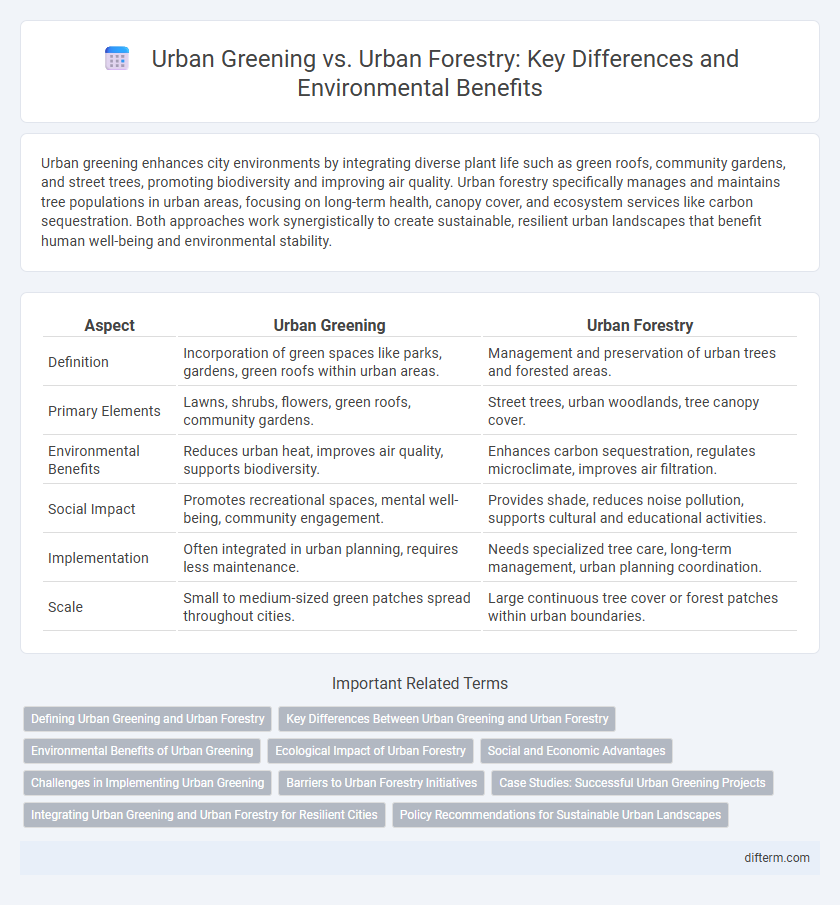Urban greening enhances city environments by integrating diverse plant life such as green roofs, community gardens, and street trees, promoting biodiversity and improving air quality. Urban forestry specifically manages and maintains tree populations in urban areas, focusing on long-term health, canopy cover, and ecosystem services like carbon sequestration. Both approaches work synergistically to create sustainable, resilient urban landscapes that benefit human well-being and environmental stability.
Table of Comparison
| Aspect | Urban Greening | Urban Forestry |
|---|---|---|
| Definition | Incorporation of green spaces like parks, gardens, green roofs within urban areas. | Management and preservation of urban trees and forested areas. |
| Primary Elements | Lawns, shrubs, flowers, green roofs, community gardens. | Street trees, urban woodlands, tree canopy cover. |
| Environmental Benefits | Reduces urban heat, improves air quality, supports biodiversity. | Enhances carbon sequestration, regulates microclimate, improves air filtration. |
| Social Impact | Promotes recreational spaces, mental well-being, community engagement. | Provides shade, reduces noise pollution, supports cultural and educational activities. |
| Implementation | Often integrated in urban planning, requires less maintenance. | Needs specialized tree care, long-term management, urban planning coordination. |
| Scale | Small to medium-sized green patches spread throughout cities. | Large continuous tree cover or forest patches within urban boundaries. |
Defining Urban Greening and Urban Forestry
Urban greening encompasses a broad range of initiatives aimed at increasing green spaces in cities, including parks, green roofs, community gardens, and street trees, enhancing biodiversity and improving air quality. Urban forestry specifically focuses on the management, care, and cultivation of trees and forested areas within urban environments to optimize ecological, social, and economic benefits. Both concepts contribute to sustainable urban development but differ in scope, with urban forestry being a subset of urban greening dedicated to trees and forest ecosystems.
Key Differences Between Urban Greening and Urban Forestry
Urban greening encompasses a broad range of initiatives including parks, green roofs, and community gardens aimed at increasing vegetation in urban areas, while urban forestry specifically focuses on the management and care of trees within cities. Urban forestry involves systematic planning, planting, and maintenance of tree populations to improve environmental quality and enhance urban ecosystems. In contrast, urban greening promotes overall greenery to support biodiversity, reduce heat islands, and improve air and water quality beyond tree-specific efforts.
Environmental Benefits of Urban Greening
Urban greening enhances air quality by increasing vegetation cover, which absorbs pollutants and mitigates urban heat island effects. It promotes biodiversity by creating habitats for various species within city landscapes, supporting ecological balance. Moreover, urban greening improves stormwater management through natural infiltration and reduces carbon footprints, contributing to climate change mitigation.
Ecological Impact of Urban Forestry
Urban forestry significantly enhances biodiversity by creating diverse habitats within city landscapes, which supports a wide range of flora and fauna. Its deep-rooted trees improve air quality by filtering pollutants and sequestering carbon dioxide, contributing to climate change mitigation. Urban forestry also stabilizes soil and reduces stormwater runoff, thus preventing erosion and improving water quality in urban ecosystems.
Social and Economic Advantages
Urban greening enhances community well-being by creating accessible green spaces that encourage social interaction and physical activity, reducing healthcare costs through improved mental and physical health outcomes. Urban forestry contributes to economic advantages by increasing property values, attracting businesses, and reducing energy expenses through natural cooling and air purification. Both strategies foster social cohesion and stimulate local economies by promoting sustainable urban development and environmental resilience.
Challenges in Implementing Urban Greening
Limited space in densely populated cities poses a significant challenge for urban greening initiatives, restricting the selection and growth of plant species. Inconsistent funding and maintenance resources often lead to the neglect of green spaces, undermining their ecological and social benefits. Furthermore, balancing diverse stakeholder interests, including residents, businesses, and local governments, complicates the strategic planning and long-term sustainability of urban greening projects.
Barriers to Urban Forestry Initiatives
Limited funding, inadequate policy support, and competing land use priorities significantly hinder urban forestry initiatives, reducing tree canopy expansion and biodiversity benefits. Public awareness gaps and maintenance challenges further obstruct the sustainable growth of urban forests in densely populated areas. Overcoming these barriers requires targeted investment, community engagement, and integrated planning frameworks to enhance urban ecosystem resilience.
Case Studies: Successful Urban Greening Projects
Case studies of successful urban greening projects highlight initiatives like Singapore's Gardens by the Bay, which integrates diverse plant species into urban design to enhance biodiversity and air quality. New York City's MillionTreesNYC campaign demonstrated the impact of large-scale tree planting on reducing urban heat islands and improving mental health. These projects exemplify the tangible environmental and social benefits of combining urban forestry with green infrastructure in metropolitan areas.
Integrating Urban Greening and Urban Forestry for Resilient Cities
Integrating urban greening and urban forestry enhances city resilience by combining diverse plant species with strategic tree canopy management to improve air quality, reduce heat islands, and support biodiversity. Urban greening initiatives, such as green roofs and community gardens, complement urban forestry's focus on mature tree preservation and forested urban spaces, creating multifunctional green infrastructure that mitigates stormwater runoff and carbon emissions. This holistic approach supports sustainable urban ecosystems, promotes climate adaptation, and fosters healthier living environments for urban populations.
Policy Recommendations for Sustainable Urban Landscapes
Urban greening initiatives should prioritize diverse, native plant species to enhance biodiversity and climate resilience, while urban forestry policies must ensure the protection and expansion of mature tree canopies to mitigate urban heat islands. Integrating green infrastructure with community engagement fosters equitable access to green spaces, supporting mental health and social cohesion. Policymakers should implement zoning regulations that mandate green space inclusion in new developments and allocate funding for long-term maintenance and monitoring of urban vegetation health.
urban greening vs urban forestry Infographic

 difterm.com
difterm.com